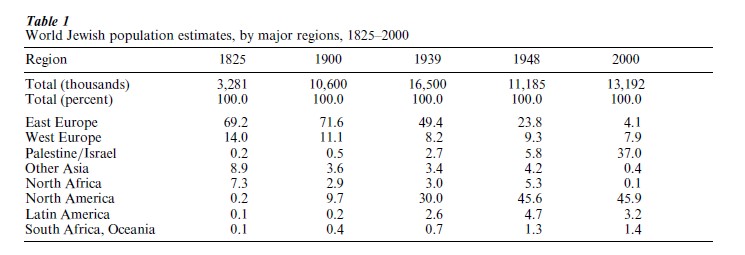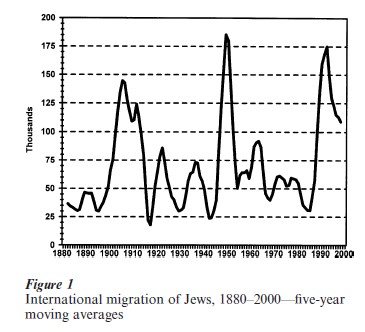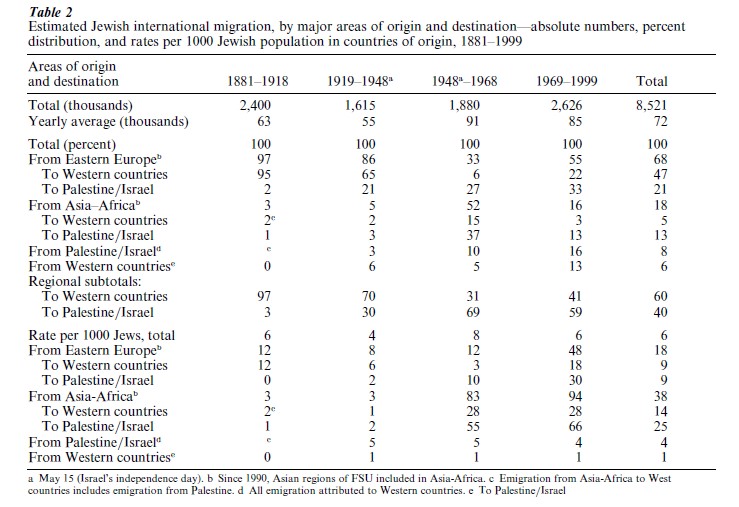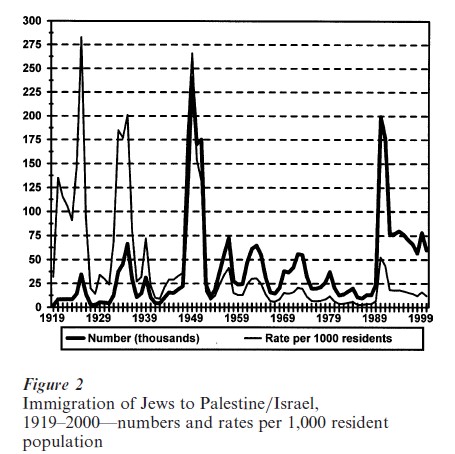Sample Jewish Diaspora Research Paper. Browse other research paper examples and check the list of research paper topics for more inspiration. If you need a research paper written according to all the academic standards, you can always turn to our experienced writers for help. This is how your paper can get an A! Feel free to contact our custom research paper writing service for professional assistance. We offer high-quality assignments for reasonable rates.
The study of international migration focuses on individuals or groups of people moving between countries. National boundaries constitute one key criterion in assessing which geographical mobility constitutes international migration, as well as the sociodemographic profile of the different relevant populations: the whole residents of a given country of emigration, the particular subset of actual movers, and the residents of immigration-receiving countries. Within this framework, the study of a diaspora is atypical. Rather than a clearly defined territorial entity, a diaspora is a globally dispersed set of subpopulations mutually related by common values, symbols, and historical experiences. Besides describing the experiences of each local subpopulation, diaspora studies aim to uncover the existence, determinants, and consequences of common patterns, if any.
Academic Writing, Editing, Proofreading, And Problem Solving Services
Get 10% OFF with 24START discount code
The Jewish diaspora is a particular case of such a territorially dispersed sociodemographic collective de- fined by religious–ethnic–cultural criteria. Variable definitions of ‘who is a Jew’ may affect evaluation of sociodemographic change (DellaPergola et al. 2000). While during earlier history group boundaries were rather rigid, namely concerning the status of the Jews, in the modern era of political emancipation, modernization, secularization, intensive communication and social interaction, religious, ethnic, national, or cultural identities tended to blur. While a declining number of countries have provided relevant information on Jews (or Hebrews) as a religious or ethnic category in their censuses and migration statistics, more recent sources such as population surveys increasingly rely on the respondents’ self-definitions of group identity. The identificational boundaries and consequent quantitative assessment of Jewish populations become increasingly operative as people may declare different identifications under variable circumstances. However, since 1950 the state of Israel has used a broad normative definitional framework through the Law of Return (Hok hashvut) granting immediate Israeli citizenship to Jewish immigrants, their children, grandchildren, and respective spouses, even if they are not Jewish. The related concepts of a core Jewish population, and an enlarged Jewish population also including non-Jews of Jewish origin and other non-Jewish household members, should be kept in mind in the study of the Jewish diaspora’s sociodemographic change, including international migration.
1. Geographical Change In Historical Perspective
Like other diasporas but to a greater extent than for other groups, Jewish international migration has spread over a very long time span. The unique amount of geographical mobility experienced by Jews over history stands behind the negative stereotype of the wandering people—a rootless ideal type presumably associated with other negative characteristics. While repeated large-scale migrations did occur along Jewish history, explanations stem from a complex array of political, economic, social, and cultural determinants. In a historical perspective, minority status often exposed Jewish populations to legal, socioeconomic, and cultural constraints. These influences deeply cut across Jewish communities worldwide, though in each locale significantly different sociopolitical and cultural environments generated unique incentives or constraints to stay or move. Repeatedly in the Jewish experience this took the form of expulsions or deportations.
The main focus of this research paper is since 1850 with an emphasis on the period after World War II. It suffices, therefore, to note that Jewish populations had high levels of geographical mobility from antiquity throughout the middle ages and the early modern period. The initial stages of Jewish peoplehood formation and consolidation occurred through wanderings across the area between Mesopotamia and Egypt. The land of Canaan—later known as Eretz Israel, the Holy Land, and Palestine—eventually became the center of ancient Jewish settlement and political hegemony. A Jewish diaspora was permanently established by since the deportation to Babylon (eighth to sixth centuries BC). The Jewish presence expanded to North Africa and Southern Europe during the last centuries BC and the first centuries CE after the fall of the second Jewish Temple under the Roman Empire, and especially following the westward expansion of Islam since the seventh century. By the end of the first millennium northbound migration had led to the consolidation of the culturally influential Jewish communities of Ashkenaz (Germany in Hebrew). Jewish population growth in the Iberian peninsula created the other main cultural center of Sepharad (Spain in Hebrew). It is only after the thirteenth century that significant numbers of Jews moved eastward to Poland and Lithuania, eventually expanding to the whole of Eastern Europe.
Reflecting these migrations, the main centers of Jewish settlement repeatedly shifted. Evidence from the late twelfth century still points to a predominantly Middle Eastern geographical distribution. The subsequent rise of Western European Jewry was curtailed by numerous expulsions from European cities, provinces and countries, culminating in the major exodus of Jews from Spain and Portugal in the fifteenth and sixteenth centuries and their dispersal throughout Europe, the Mediterranean, and the Caribbean. Eastern Europe consequently became the main regional center of Jewish presence.
Following at least ten centuries of stagnation at an estimated level of a few hundred thousands to slightly above one million, since the early seventeenth century world Jewish population rapidly increased, mostly in Eastern Europe. The estimated global total grew from 1 million in 1700 to 2.5 million in 1800, 10.6 million in 1900, and 16.5 million in 1939. Demographic change reflected a comparatively early transition to lower levels of mortality in the presence of widespread marriage and moderate to high fertility. Rapid population growth and a consequent impoverishment along with the social–environmental pressure of anti-Semitism accompanied by outbursts of physical violence stimulated large-scale Jewish transoceanic migration during the last two decades of the nineteenth century and the first two decades of the twentieth century. Major Jewish communities thus rose in the US, Canada, Latin America, Southern Africa, and Australia.
After World War II and the destruction of Jewish communities in Central and Eastern Europe (6 million estimated victims), North America became the largest regional concentration of world Jewry. Since independence in 1948, large-scale immigration was the leading factor in Israel’s rapid rise to have the second largest Jewish population worldwide, drawing from all diaspora communities but especially from Eastern Europe, North Africa and the Middle East. Table 1 summarizes the main changes in world Jewish population distribution over the nineteenth and twentieth centuries.

2. Volume Of Jewish Migration, Countries Of Origin And Countries Of Destination
The changing structure and interrelated character of modern Jewish international migration fits a systemic perspective (Kritz et al. 1991). The number, direction and characteristics of Jewish migrants at any time were significantly determined by the existing worldwide distribution of Jews—in turn, to a large extent, the product of previous migration (DellaPergola 1998; Lestschinsky 1960; Schmelz 1971).
About a quarter of a million Jews migrated mostly from Central Europe between 1840 and 1880. Estimates of the changing volume of Jewish international migration between 1880 and 2000 are presented in Fig. 1. Five-year moving averages were computed from yearly migration data and estimates for each of the main countries of destination. Overall, over eight and a half million Jews migrated between continents, including all Jewish migration to Israel and to the US. Of these, about 2.4 million moved between 1880 and 1918, 1.6 million between 1919 and 1948, 1.9 million between 1948 and 1968, and about 2.6 million between 1969 and 1999. These figures do not include several hundred thousands more who migrated between neighboring countries within the same continent, nor does it provide a full account of return migration.

The continuous wave-like pattern in Jewish international migration demonstrates recurrent crises affecting the position of Jewish communities in different parts of the world and the consequent need for prompt relocation, which in turn suggests dependency of the Jewish diaspora on changing political, socioeconomic, and cultural circumstances in the respective countries. Some of the stimulating factors of largescale emigration operated in recent years in essentially the same way as they did at the turn of the twentieth century in spite of the deep intervening sociopolitical changes across world society and Jewish communities alike.
Three major waves were: (a) the pre-World War I mass migration from Eastern Europe to North America, peaking in fiscal years 1905–1906 (154,000 Jews admitted), 1906–1907 (149,000) and 1913 14 (138,000); (b) the massive transfer to Israel of displaced and refugee Holocaust survivors and of sizeable Middle Eastern and North African Jewish communities between 1948 (239,000 in 1949) and 1951; and (c) the more recent exodus from the former Soviet Union (FSU) (228,000 in 1990 and 195,000 in 1991). These major moments of crisis or post-crisis adaptation occurred at comparable intervals of about 40–45 years, much in response to major events in the global polity (pre-World War I and post-World War II adjustments, the end of the Soviet Union). While no mechanical or deterministic assumption is suggested about the alignment of global geo-political forces, economists and demographers have discussed the possible cyclical unfolding of economic change and its impact on national political systems (Kuznets 1958). Consequences for specific social or ethnoreligious groups tended to stimulate mass migration.
The volume of the main Jewish migration flows is summarized in Table 2 according to a fourfold typology: Eastern Europe; Muslim countries in Asia and Africa; Western countries including America and Western Europe; Ottoman and British Palestine turning since 1948 into the state of Israel. Until 1918, Eastern Europe was the main sending region and the US the main recipient. During the inter-war period, Eastern Europe continued to be the main area of origin but migration was sparser and Palestine emerged as a main country of destination. Since 1948, Israel became the dominant country of destination, especially between 1948 and 1968 when the majority of Jewish migrants came from Muslim countries in Asia and Africa. Since 1969 Eastern Europe again became the main supplier. Over the whole period 1881–1999, 60 percent of all Jewish migrants went to Western countries, primarily the US, and 40 percent went to Palestine Israel.

Against the predominant Eastern European origin of Jewish migration, its intensity as reflected by yearly rates of emigration per 1000 Jews in the countries of origin was highest from North Africa and the Middle East, fairly low and declining from Israel, and lowest from migration-receiving western countries. At the beginning of the twenty-first century, the overwhelming majority of world Jewish population was located in countries with low emigration propensities. In prospective, and short of significant changes in the current global and regional circumstances, Jewish international migration was bound to decline.
Jewish migration to Israel, usually called by the value-oriented term of aliyah (ascent in Hebrew) consistently followed a wave-like pattern. Historiography has numbered such migration waves serially, starting with the ‘first’ (1881–1903) through the ‘fifth aliyah’ (1932–1938). The same cyclical pattern actually prevailed throughout the nineteenth century, though with relatively small numbers of migrants, and it clearly continued after Israel’s independence. In absolute numbers the greatest single wave occurred in 1948–1951, followed by others of declining size until the major surge of the early 1990s. However, relative to a rapidly expanding receiving population, the highest and quite unique impact of immigration on the receiving society was recorded during the ‘fourth aliyah’ (283 immigrants per 1000 Jewish residents in 1925), followed by Israel’s ‘great aliyah’ (236 per 1000 in 1948 and 266 per 1000 in 1949) and the ‘fifth aliyah’ (201 per 1000 in 1935) (see Fig. 2).

3. Main Determinants Of Jewish Migration
International migration has usually represented a major mechanism of adjustment for Jewish communities endangered by disruption of the orderly relationship with the surrounding society and severe worsening of civic rights and economic opportunities. Besides the variable intensity of pro-migration forces reflecting the socioeconomic and political situation within countries of origin (DellaPergola 1998), migration policies were an important factor (Bachi 1977, Friedlander and Goldscheider 1979). Regarding the actual possibility to leave, during the inter-war period and after World War II restrictive Jewish emigration policies were implemented by the Soviet Union and its allied countries in Eastern Europe (in the framework of more general limitations) and other mostly Middle Eastern countries. The effect of border opening is clearly demonstrated by the migration wave from the FSU in the 1990s.
Availability of alternative countries of destination crucially affected the volume and direction of Jewish migration. The landmark was the introduction of restrictive immigration policies by the US in 1921 and 1924. The latter established annual quotas for each country of origin amounting to no more that 2 percent of the respective population already present in the US by 1890. The number of Jewish immigrants to the US was forced down drastically to 10,000 per year. Restrictions followed in Canada, Argentina, Brazil, South Africa, Australia, Palestine (based on ‘economic absorptive capacity’), and in Western Europe. Opportunities radically changed after Israel’s independence in 1948 and its opening to virtually unrestricted Jewish migration. Israel’s ideological call for mass Jewish immigration came together with instant citizenship rights and a modicum of socioeconomic help aimed at easing the initial integration of new immigrant households. Since World War II repeated changes in the Jewish quota again affected the number of Jewish migrants to the US, namely from the FSU. Around 2000, Germany was the second main recipient of Jewish migration after Israel.
Assistance provided by Jewish international and Israeli agencies generally enhanced migration. Various bodies promoted, directed, supported, and subsidized Jewish migrants, such as the Jewish Colonization Association (JCA), the World Zionist Organization, the Jewish Agency for Israel, the American Jewish Joint Distribution Committee (JDC), the Hebrew Immigrant Aid Society (HIAS), and Nativ, the liaison bureau of Israel’s government in the FSU (Avni 1991, DellaPergola 1998, Wischnitzer 1948).
The recent migrants’ feedback reflected their satisfaction with the situation in the new countries. Information sent back to family and other social networks in the countries of origin significantly affected the latter’s decisions about further emigration. The final impact of migration was determined by the amount of return migration. The ratio of net to total immigration was generally higher among Jews than among other comparable groups. At the peak of migration to the US in 1908–1924, the amount of return migration was 5 percent among Jews versus 33 percent among all immigrants (Hersch 1931, Sicron 1957). Later, the rate of immigration retention was higher in Israel (78 percent in 1948–1998, including emigration of Israeli-born) than in the US, Argentina, Brazil, Australia, New Zealand, and countries in West Europe at the peak of the respective immigrations. Short-term economic determinants were the main explanatory factor of emigration from Israel.
4. Characteristics Of Migrants
The demographic, socioeconomic, and sociocultural characteristics of the Jewish population significantly affected differential propensities to emigrate, and the choice of country of destination.
4.1 Demographic Characteristics
Because of its political–cultural character and its more irreversible, rather than merely economic and temporary nature, Jewish migration was comparatively less demographically selective than other migration streams. Entire families moved, including men and women of the whole age range rather than just young single individuals. This meant comparatively high dependency ratios. Wide demographic differences separated Jewish diaspora communities that had undergone different degrees of modernization, such as the contrast between Jewish populations in Europe and populations in North Africa and the Middle East. In comparison, Jewish migration to Israel included more child and elderly dependents than migration from similar countries of origin to western countries such as the US or France.
4.2 Socioeconomic Characteristics
Jewish migrants included a broad cross-section in terms of socioeconomic stratification. Jews usually had higher-than-average education in the respective environments, with special concentrations in trade, selected branches of industry, and the liberal professions. Jewish migration propensities were higher at the lower and upper ends of the social spectrum. Here again structural differences that had emerged in the diaspora affected the characteristics of migrants to different countries. Israel absorbed a comparatively higher proportion of migrants previously employed in trade and blue-collar occupations. The difference was especially notable in the case of migration from North Africa to France and to Israel during the 1950s and 1960s (Bensimon and DellaPergola 1984, Sicron 1957). Immigration from Western countries and the more recent wave from the FSU contributed unusually high proportions of university graduates that enhanced the quality of Israel’s labor force.
4.3 Ethno-Religious Identification
While the general definition of Jewish migration applies to the whole of migration flows reported here, not all of the migrants who moved together as families or as communities were actually Jewish. Intensive assimilation experienced by Jews in the diaspora in recent decades translated into high percentages of mixed marriages. The enlarged Jewish population inclusive of non-Jewish household members in the FSU at the close of the twentieth century amounted to twice or more the size of the core Jewish population. The number and proportion of people entitled to emigrate under special provisions for Jewish migrants established in Israel under the Law of Return, in the US quota system, and in Germany, therefore tended to grow significantly.
5. Consequences For Jewish Communities And For Countries Of Destination
Mass relocation played a crucial role in shifting the main centers of Jewish presence globally. Even more significantly, the passage from less to more modern environments produced significant changes in demographic behavior, socioeconomic opportunities, and cultural outlook among Jewish communities. In the US and other western countries, successful immigrant absorption over a three-generation span stimulated a fast rise of Jews from one of the lowest to one of the highest-ranked ethnic and religious groups in the social ladder.
In Israel, absorption of mass migration created the backbone of a new society and significantly stimulated national economic growth and complexity (Metzer 1998). Between 1948 and 2000, net migration contributed about one half of Israel’s total population growth of 4.3 million, while much of the natural increase was produced by immigrants and their descendants. Diverse levels of modernization and socioeconomic development attained by Jewish diaspora communities in the respective countries translated into internal social gaps within the new framework of Israeli society. The ingathering of the exiles and fusion of the diasporas became central tenets of Israeli social policies both in the immediate and in the longer term (Bachi 1977, Schmelz et al. 1991).
Bibliography:
- Avni H 1991 Argentina and the Jews: A History of Jewish Immigration. The University of Alabama Press, Tuscaloosa, AL
- Bachi R 1977 The Population of Israel. The Hebrew University, Jerusalem
- Bensimon D, DellaPergola S 1984 La Population Juive de France: Sociodemographie et Identite. The Hebrew University, Jerusalem, and Centre National de la Recherche Scientifique, Paris
- DellaPergola S 1998 The global context of migration to Israel. In: Leshem E, Shuval J T (eds.) Immigration to Israel: Sociological Perspectives. Transaction, NB, Canada, pp. 51–92
- DellaPergola S, Rebhun U, Tolts M 2000 Prospecting the Jewish future: population projections 2000–2080. American Jewish Year Book 100: 103–46
- Friedlander D, Goldscheider C 1979 The Population of Israel. Columbia University Press, New York
- Hersch L 1931 International migration of the Jews. In: Wilcox W (ed.) International Migration. National Bureau of Economic Research, New York, Vol. 2, pp. 471–520
- Kritz M M, Lim L L, Zlotnik H 1991 International Migration Systems: A Global Approach. Oxford University Press, Oxford, UK
- Kuznets S 1958 Long swings in the growth of population and in related economic variables. Proceedings of the American Philosophical Society 102: 25–52
- Lestschinsky J 1960 Jewish migrations, 1840–1956. In: Finkelstein L (ed.) The Jews: Their History, Culture and Religion. Harper, New York, Vol. 2, pp. 1536–96
- Metzer J 1998 The Divided Economy of Mandatory Palestine. Cambridge University Press, Cambridge, UK
- Schmelz U O 1971 Migrations. Encyclopaedia Judaica. Keter, Jerusalem, Vol. 16, pp. 1518–29
- Schmelz U O, DellaPergola S, Avner U 1991 Ethnic Differences Among Israeli Jews: A New Look. The Hebrew University and American Jewish Committee, Jerusalem
- Sicron M 1957 Immigration to Israel, 1948–1953. Falk project for economic research in Israel and Israel central bureau of statistics, Jerusalem
- Wischnitzer M 1948 To Dwell in Safety: The Story of Jewish Migration since 1800. Jewish Publication Society, Philadelphia




